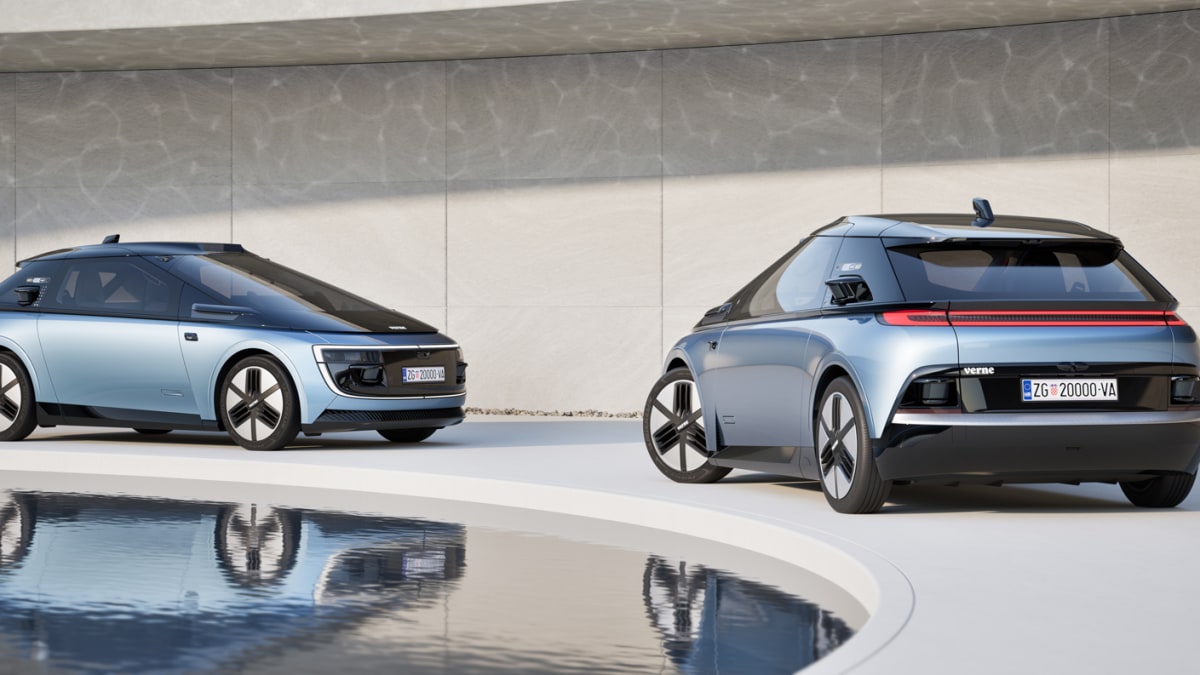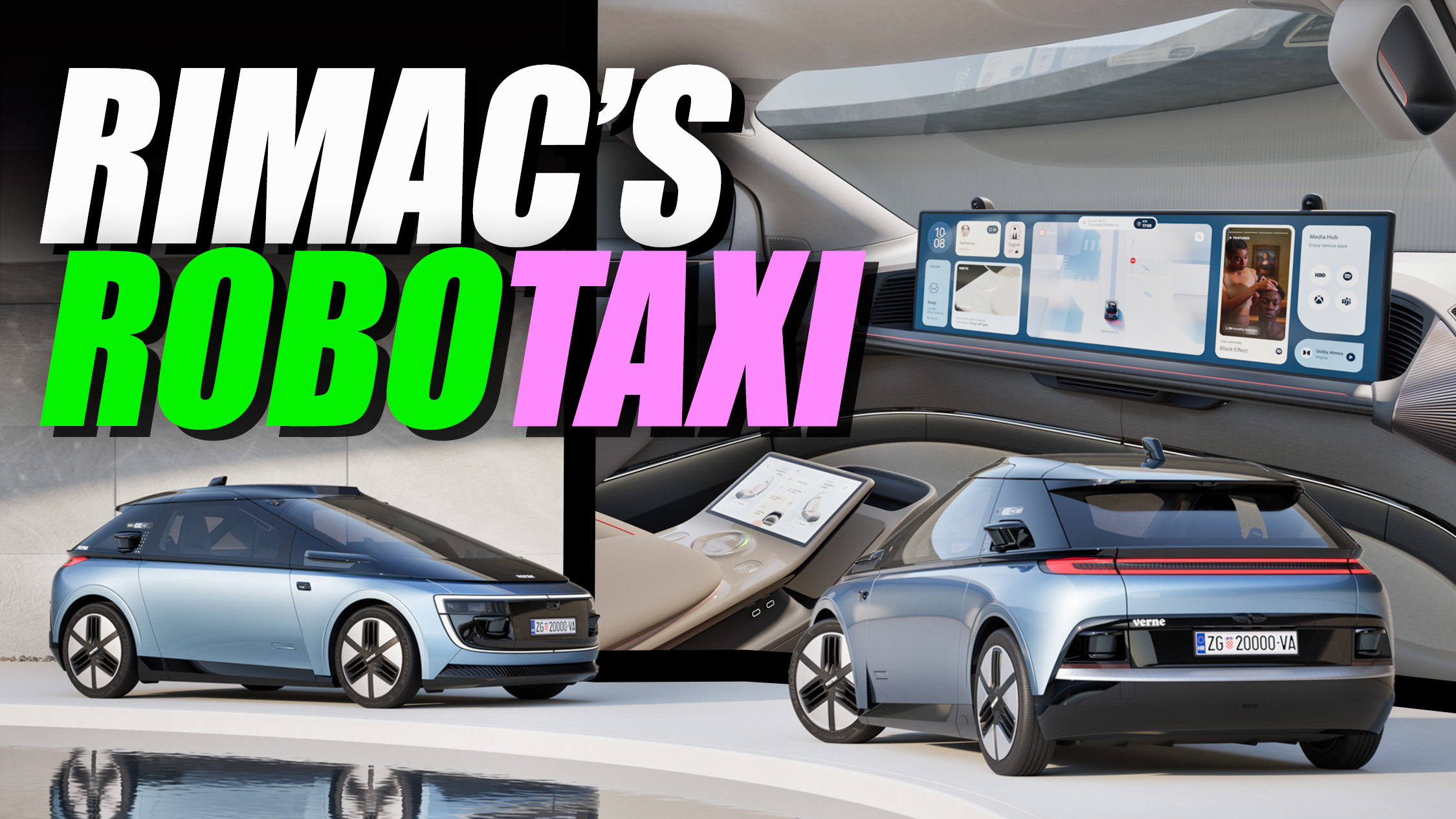Rimac has unveiled Verne, a self-driving two-seater for urban mobility. Named after the iconic author Jules Verne, this autonomous taxi service is convenience and efficiency in ride-hailing. Scheduled for launch in Croatia in 2026, Verne will soon expand to the UK and Germany.

Also Read: 2025 BMW M5: A Sedan with 717-HP Hybrid Powertrain
Rimac has introduced Verne as a spin-off from the company previously known as P3 Mobility. The focus is on creating a radical two-seat electric hatchback designed exclusively for autonomous urban transportation.
The robotaxi has been designed from the inside out, prioritizing interior space, ergonomics and entertainment.
This approach contrasts with traditional automotive design, which often focuses on external aesthetics first. The hatchback design was chosen for its practicality for ease of access and sufficient storage space.
The robotaxi has an interior that rivals the space and comfort of luxury vehicles like Rolls-Royce. The seats are extra-large and offer five different position settings.
Replacing the traditional dashboard is a massive 43-inch display screen controlled via a touchpad on the center console.
This screen serves multiple functions including entertainment and journey information. According to Adriano Mudri, the designer behind both the Rimac Nevera and Verne, the goal was to create an interior more akin to a living room than a car.
Developed in partnership with Mobileye, an Israeli tech firm under Intel, Verne’s autonomous driving system integrates cameras, radars and lidars into the vehicle’s design, eliminating the need for traditional features like windshield wipers and side-view mirrors.
The robotaxi is built on a new electric car platform designed to adapt to various environments and driving conditions.
The app allows passengers to pre-condition the vehicle’s interior to their exact preferences including temperature and scent.
The robotaxi promises a level of reliability that addresses common issues in ride-hailing services such as canceled rides.
The service will debut in Zagreb, Croatia, in 2026, with plans to expand to the UK and Germany in 2027. Verne has already secured agreements with 11 additional cities.
A network of motherships will support the service in each city. These hubs will serve as bases for vehicle maintenance, charging and cleaning.
Mate Rimac, co-founder of the Verne initiative addressed the goal of providing a superior mobility experience that is affordable for all, making high-quality autonomous transportation accessible to a wide audience.
The all-electric Verne taxi is designed to operate efficiently with a 60 kWh LFP battery, offering a range of 240 kilometers (approximately 125 miles), sufficient for city operations without the need for larger, more expensive batteries.
The robotaxi is powered by an electric motor with an output of around 150 kW, optimized for city driving. The focus is on balancing performance with cost-effectiveness to make the service economically viable.
Also Read: Bugatti Tourbillon: A $4 Million Hybrid Hypercar with 1,800 Horsepower
The vehicle is equipped with three long-distance and six short-distance lidar sensors along with 13 cameras.
Rimac has been exploring autonomous technology since 2017, gradually building the foundation for its robotaxi project.
In 2021, the company received €200 million from the European Union as part of a larger €6.3 billion recovery plan for Croatia.
Rimac has also secured funding from major automotive players such as Hyundai and Kia.
The project will be led by Marko Pejković as CEO, a close associate of Rimac founder Mate Rimac, with Adriano Mudri, designer of the Nevera hypercar taking on the role of chief designer.
The robotaxi will utilize Mobileye’s Drive system for its autonomous capabilities. This includes the EyeQ system-on-a-chip and the Road Experience Management (REM) system which creates a dynamic 3D map using real-time data.
The robotaxi is designed as a Level 4 autonomous vehicle, eliminating traditional driving controls such as a steering wheel and pedals and introducing a futuristic driving experience.
With only two seats, the Verne offers more space and luxury than typical robotaxis. The design rationale is based on data showing that most rides are used by one or two people.
The cabin has a 43-inch widescreen display for entertainment and navigation complemented by a Dolby Atmos sound system with 17 speakers.
Users can summon a Verne robotaxi via a mobile app similar to services like Uber and Waymo. The app allows customization of settings such as temperature, lighting and even scent.
While lacking traditional driving controls, the vehicle features a median switch for basic ride functions and a touchscreen control panel for adjusting settings.
Verne’s fleet will be interconnected for optimized management with centralized depots called “Motherships” for maintenance, cleaning and charging.
Verne’s first deployment will be in Zagreb, Croatia, followed by expansions into the UK, Germany, and the Middle East. The company has agreements with 11 cities and is negotiating with over 30 others globally.
Verne plans to become the first major robotaxi operator outside the US and China, where companies like Waymo and Baidu are currently leading.
With a 2026 launch date, Rimac is ahead of Tesla in revealing a timeline for a robotaxi service. Tesla’s plans for its robotaxi set to be unveiled in August.
Also Read: Ferrari’s First Electric Vehicle Set to Launch with a $500,000 Price





